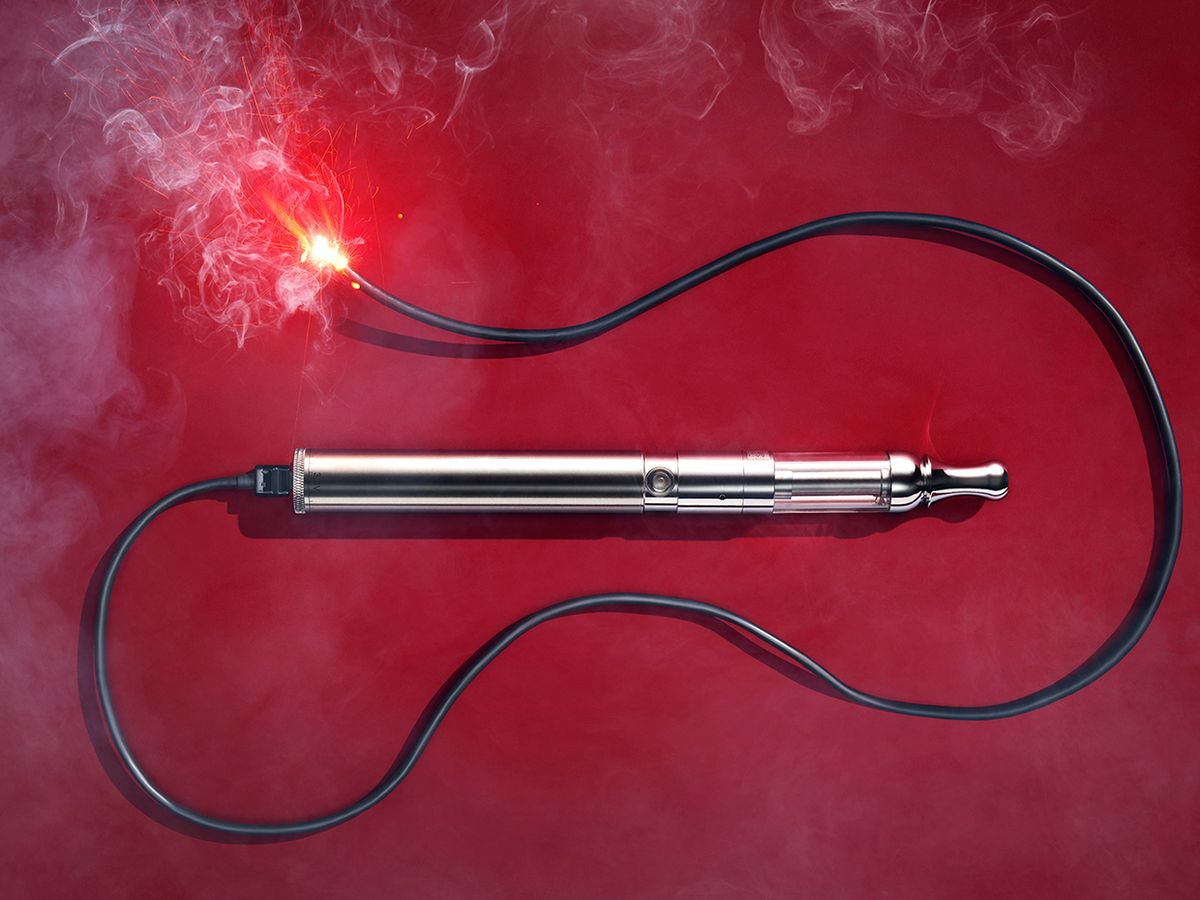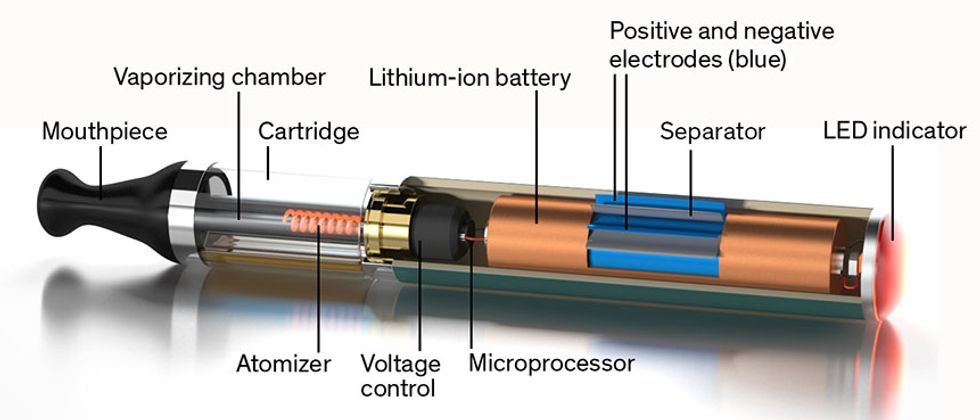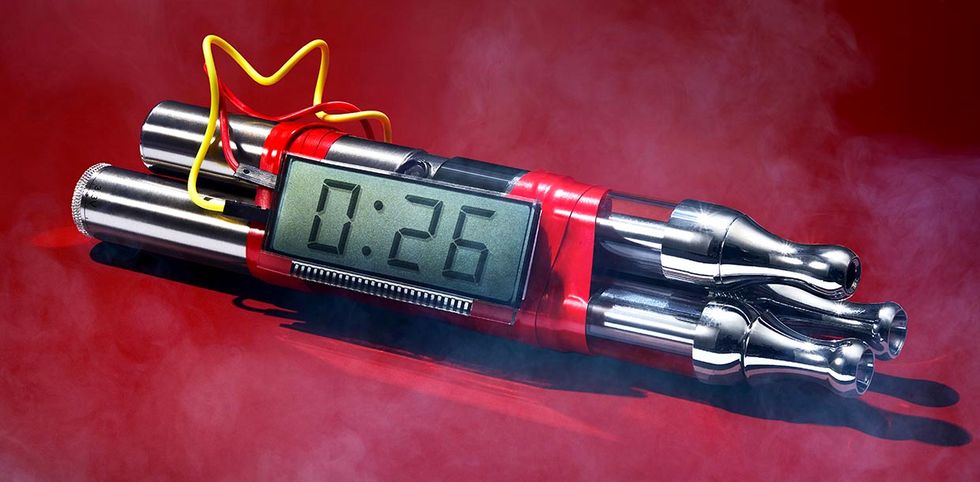Exploding E-Cigarettes Are a Growing Danger to Public Health
Whatever their physiological effects, the most immediate threat of these nicotine-delivery devices comes from a battery problem called thermal runaway

On 23 November 2016, as he stood behind the counter of a wine store in New York City, Otis Gooding felt an explosion on his right thigh. The e-cigarette he’d been carrying in his pants pocket had suddenly erupted like a small fireworks display. As a security camera later showed, the 31-year-old Gooding struggled to pull the burning device out of his pants. Gooding would later need a skin graft and 51 staples, and he may never recover the full use of his hand.
Exploding cigarettes sound like a party joke, but today’s version isn’t funny at all. In fact, they are a growing danger to public health. Aside from mobile phones, no other electrical device is so commonly carried close to the body. And, like cellphones, e-cigarettes pack substantial battery power. So far, most of the safety concerns regarding this device have centered on the physiological effects of nicotine and of the other heated, aerosolized constituents of the vapor that carries nicotine into the lungs. That focus now needs to be widened to include the threat of thermal runaway in the batteries, especially the lithium-ion variety.
In July 2017, the National Fire Data Center of the U.S. Fire Administration identified 195 separate e-cigarette incidents in the United States between January 2009 and 31 December 2016. Thirty-eight incidents resulted in third-degree burns, facial injuries, or the loss of a body part. The number of fires and explosions has risen in tandem with the rise in e-cigarette sales. The report also notes the lack of regulations, codes, or laws governing the safety of the batteries in e-cigarettes. And there’s reason to believe that many cases of injury are never registered with government authorities. An online blog asserts that at least 243 e-cigarette explosions occurred from August 2009 to April 2017, resulting in 158 personal injuries. Other explosions harmed animals or property.

E-cigarettes, also known as “vape pens,” “e-hookahs,” “mods,” “e-pipes,” “cigalikes,” and “tank systems,” are basically just electronic nicotine-delivery systems. They were first commercialized in China in 2004, and the most recent available estimate put that country’s share of total production above 90 percent. In 2015, U.S. consumers accounted for about 43 percent of the US $8 billion world market for these devices.
An e-cigarette typically consists of a cartridge containing a liquid, an atomizer based on a heating element, and a battery that powers the heating element. When the user inhales, the airflow activates a flow trigger, and the heating element vaporizes the liquid—a solution of propylene glycol, glycerin, flavoring, and varying levels of nicotine.
Lithium-ion batteries are suitable for e-cigarettes because they are rechargeable and have high levels of energy density and voltage. But under certain conditions, the battery can fail spectacularly through a process known as thermal runaway. In this situation, internal defects cause short circuits, which raise the temperature enough to spur on reactions that release still more heat. Ultimately, this feedback loop leads to sparking, fiery self-destruction. Significantly, this phenomenon is more likely in an e-cigarette than in a cellphone because the combination of lithium-ion batteries with a heating element increases the risk of such a reaction. A battery-management system can help with the problem, but it may not prevent catastrophic failure if poor manufacturing and quality control leave defects in the battery.
During thermal runaway, battery temperatures can reach 900 oC and release flammable and toxic gases. Well-known examples of thermal runaway include the various battery fires that led to the worldwide grounding of the Boeing 787 Dreamliner aircraft on 16 January 2013; other notable incidents involved hoverboards and Samsung’s Galaxy Note 7 smartphone.
The way to stop the problem is by ensuring high manufacturing quality. Many of the batteries included in e-cigarettes have an excessively high rate of internal defects. These include foreign matter (dust, contaminants, even moisture) and poorly formed electrodes or separator—the membrane that prevents short circuits by keeping the electrodes apart, while allowing the passage of ions during charging or discharging. Low-quality machining can result in small metal protrusions, or it can cover the electrodes in unwanted metallic particles. These flaws can also lead to short circuits in the battery. For instance, the electrode can have burrs that can tear the separator. If the separator is penetrated by a wayward particle or if for some other reason a hole should form in it, enabling the anode and cathode to touch, a short circuit can ensue.
Another concern is the very construction of the batteries. Cellphones and portable computers normally use pouch cells, which are contained in a plastic wrap. But e-cigarettes typically use batteries shaped like cylinders and encased in a metal can (which is preferred to softer wraps made of plastic because it’s easier to handle and more rugged). To understand why this can be a problem, consider that during normal operation, Li-ion batteries release small amounts of gas, mostly carbon dioxide. This gas release can be contained within the can without swelling. However, during thermal runaway, gases (including toxic fluoride gases) are generated in such quantities and at such speed that the pressure can easily build up, turning the battery into a pipe bomb.
And in fact many of the people wounded by e-cigarette malfunctions suffer not so much from the heat released as from the sheer force of the explosion. One man from Orange County, Calif., lost an eye. Another man in Bakersfield, Calif., suffered injuries to his mouth and teeth. Still others have had holes blown through their cheeks.
Some companies have installed vents, similar to those in a pressure cooker, to allow gases to escape. Even so, this release mechanism is usually not sufficient to release the gases if the thermal runaway occurs at a fast pace.
It costs money, of course, to maintain high manufacturing standards. It’s not hard to see how the drive to cut costs has created incentives to use defective and substandard batteries. Such batteries enter the supply chain by different routes.
Some of the batteries may have originally been made by reputable manufacturers who identified them as substandard and labeled them as such, intending that they be used only in applications for which fire is not a pressing problem. Or maybe the batteries were meant for recycling but ended up in the hands of unscrupulous suppliers, which often rewrap low-grade batteries. That is, they put a new label on a battery and sell it under a different company name, sometimes with exaggerated ratings and occasionally at a higher price than batteries from the original manufacturers. Typically, there is no way to identify the original manufacturer.
Rewrapped battery brands often advertise inaccurate or ambiguous ratings. For example, we have found rewrapped batteries for e-cigarettes having labels indicating a 30-ampere rating that have actually turned out to be good for only 20 A. In such a case, if the product requires 30 A of current, the battery will be stressed and, possibly, damaged. While not all rewraps have exaggerated ratings or use low-grade batteries, e-cigarette device manufacturers should of course be cautious when purchasing batteries online. And if they do buy rewrapped batteries, it’s their responsibility to test them thoroughly in-house to confirm that they’re safe and that they live up to their ratings. Manufacturers should also make reliable spare batteries readily available so that if a battery fails, the user will be less likely to buy a new battery from an untrustworthy source.

Some companies are adding so-called authentication stickers to their battery labels, but this anticounterfeiting measure is worthless because it, too, can be counterfeited. Counterfeit Li-ion batteries—which have also been reported in cellphones, laptops, hoverboards, and cameras—can be created by recycling, remarking, tampering, and cloning. A Hong-Kong based investor told Quartz that “there are between 50 and 100 e-cigarette manufacturers in China alone who supply 100 to 200 brands globally.” How many e-cigarette batteries are counterfeits can’t be determined, but my laboratory at the Center for Advanced Life Cycle Engineering at the University of Maryland has found [PDF] counterfeit parts in all kinds of electronics, including weapons systems procured by branches of the United States military. It would be strange indeed if these parts were not used in e-cigarette devices.
Indeed, we know for sure of at least one use of a counterfeit battery. My group was asked to investigate a battery that caught fire in the pants pocket of an e-cigarette user, badly burning his leg. The battery label identified the company MXJO as the manufacturer and listed a Taiwanese website, www.mxjo.tw. That website provided a street address, but I found that no such address existed. Shenzhen MXJO Technology Co. (MXJO) has since told me that it has no manufacturing in Taiwan.
No specific laws govern the safety of e-cigarettes. But some government agencies have at least begun investigating the problems. In the United States, for example, in April 2017, the FDA conducted a two-day public workshop on “Battery Safety Concerns in Electronic Nicotine Delivery Systems (ENDS)” in an attempt to gather information on battery overheating, fire, explosion, and other failures. The conclusion was that the widespread availability of unvetted Li-ion batteries means that e-cigarette manufacturers must shoulder the burden of testing them, designing their systems for worst-case conditions, and making the risks known to the consumer.
In the absence of laws or regulations on e-cigarettes, legal liability may be the best way to apply pressure to makers. Already, courts have made decisions holding companies supplying e-cigarettes accountable for defective batteries. For example, in 2013 Jennifer Ries was charging her e-cigarette using the USB port in her car when the Li-ion battery exploded, giving her second-degree burns. A jury for the State Court of Southern California ruled against the e-cigarette company and awarded Ries $1.9 million for her injuries.
In the meantime, it is best that consumers buy brand-name batteries directly from reliable sources. The entire point of e-cigarettes is the health advantages gained by removing tars and other carcinogens from the smoke. It would be a shame if these advantages were undermined by public fears about devices that blow up or burn people instead.
About the Author
Michael Pecht, an IEEE Fellow, is the founder and director of the Center for Advanced Life Cycle Engineering (CALCE) electronic products and systems center, at the University of Maryland, College Park. His previous article for IEEE Spectrum, “Bogus!,” on the threat of counterfeit electronics, was published in May 2006.
This article appears in the July print issue as “When E-Cigarettes Go Boom.”

